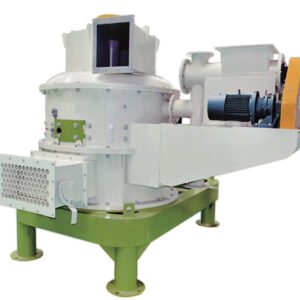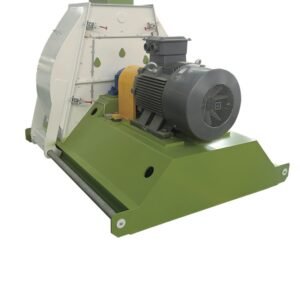Description
Technical Specifications and Design Features
Rotor System Configuration
-
Rotor diameter: 600-1500mm per rotor
-
Hammer quantity: 60-180 per rotor (depending on model size)
-
Rotational speed: 900-1800 RPM (synchronized operation)
-
Drive power: 75-600kW total (dual motor arrangement)
Hammer Design and Materials
-
Hammer types: Swing, rigid, or specialized impact designs
-
Materials: Through-hardened steel, tungsten carbide tipped, or chrome iron alloys
-
Weight range: 2-15kg per hammer (application-specific selection)
-
Wear protection: Reversible for extended service life
Screen Technology
-
Screen area: 0.8-3.2m² total active screening surface
-
Perforation sizes: 1-20mm (custom configurations available)
-
Screen materials: Hardened steel, manganese steel, or special alloys
-
Quick-change systems: Hydraulic or mechanical screen exchange
Performance Capabilities and Operational Data
Throughput Metrics
-
Capacity range: 5-50 tons/hour (varies by material and product size)
-
Reduction ratios: 15:1 to 40:1 achievable in single pass
-
Specific energy: 8-15 kWh/ton (depending on material characteristics)
-
Temperature control: Minimal heat generation due to efficient energy transfer
Particle Size Control
-
Final product range: 200μm to 10mm
-
Size distribution: Narrow spectrum with minimal oversize
-
Fines generation: Controlled through screen selection and rotor speed
-
Shape characteristics: Cubical particles preferred for many applications
Industry Applications and Performance Validation
Biomass Processing
In wood chip and agricultural residue processing:
-
Throughput: 12-18 tons/hour of woody biomass
-
Product consistency: 95% within 3-6mm range for pelletizing
-
Wear life: 600-800 hours between hammer rotation
-
Energy efficiency: 25% improvement over single-rotor systems
Mineral Processing
For limestone and industrial minerals:
-
Capacity: 20-35 tons/hour of calcium carbonate
-
Product quality: 98% passing 2mm screen
-
Abrasion resistance: Tungsten carbide hammers lasting 1200+ hours
-
Maintenance interval: 200-300 hours for routine inspection
Recycling Applications
Electronic waste and metal recovery:
-
Liberation efficiency: 85-92% metal-plastic separation
-
Throughput: 8-15 tons/hour of e-waste
-
Contamination control: Minimal cross-contamination between fractions
-
Durability: Special hardened components for abrasive materials
Operational Advantages and Economic Benefits
Performance Advantages
-
30-50% higher capacity than equivalent single-rotor mills
-
15-25% reduction in specific energy consumption
-
Improved particle size distribution control
-
Reduced vibration and smoother operation
Maintenance Benefits
-
Extended component life through balanced wear
-
Quicker screen changes with split-design access
-
Individual rotor maintenance capability
-
Reduced downtime for routine servicing
Economic Analysis
-
Capital investment: 25-40% higher than single-rotor equivalents
-
Operating cost: $1.80-3.20 per ton processed
-
ROI period: 12-24 months in high-volume applications
-
Total cost of ownership: 15-30% lower over 5-year period
Innovations and Technological Developments
Advanced Control Systems
-
Dual-motor power monitoring and balancing
-
Automated gap adjustment between rotors
-
Vibration analysis and predictive maintenance
-
Integration with plant automation systems
Material Science Improvements
-
Nano-structured alloys for extended wear life
-
Composite hammer designs for specific applications
-
Advanced screening materials reducing blinding
-
Specialized coatings for corrosive environments
Design Enhancements
-
Hydraulic opening systems for quick access
-
Rotor dynamic balancing for smooth operation
-
Enhanced airflow management for temperature control
-
Modular design for easy component replacement
Operational Guidelines and Best Practices
Application Selection Criteria
-
Ideal for medium to high moisture content materials
-
Excellent for fibrous and tough materials
-
Suitable for heat-sensitive products
-
Recommended for high-volume operations
Maintenance Protocols
-
Daily: Visual inspection and vibration monitoring
-
Weekly: Hammer condition assessment and screen inspection
-
Monthly: Bearing lubrication and wear component measurement
-
Quarterly: Comprehensive mechanical inspection
Safety Features
-
Dual-lockout systems for maintenance safety
-
Explosion protection for combustible dust applications
-
Emergency stop systems on both sides
-
Integrated metal detection and removal
Comparative Performance Analysis
Versus Single-Rotor Hammer Mills
-
35% higher capacity in similar footprint
-
Better particle size distribution control
-
Lower specific energy consumption
-
Reduced per-ton operating costs
Versus Grinding Mills
-
Higher throughput for similar energy input
-
Better control over top particle size
-
Quicker product size changes
-
Lower capital investment per ton capacity
The dual-rotor hammer mill continues to establish new standards in size reduction technology, particularly in applications demanding high capacity, precise particle control, and operational efficiency. Its innovative design addresses many limitations of traditional milling systems while providing economic advantages that justify the initial investment premium.






Reviews
There are no reviews yet.